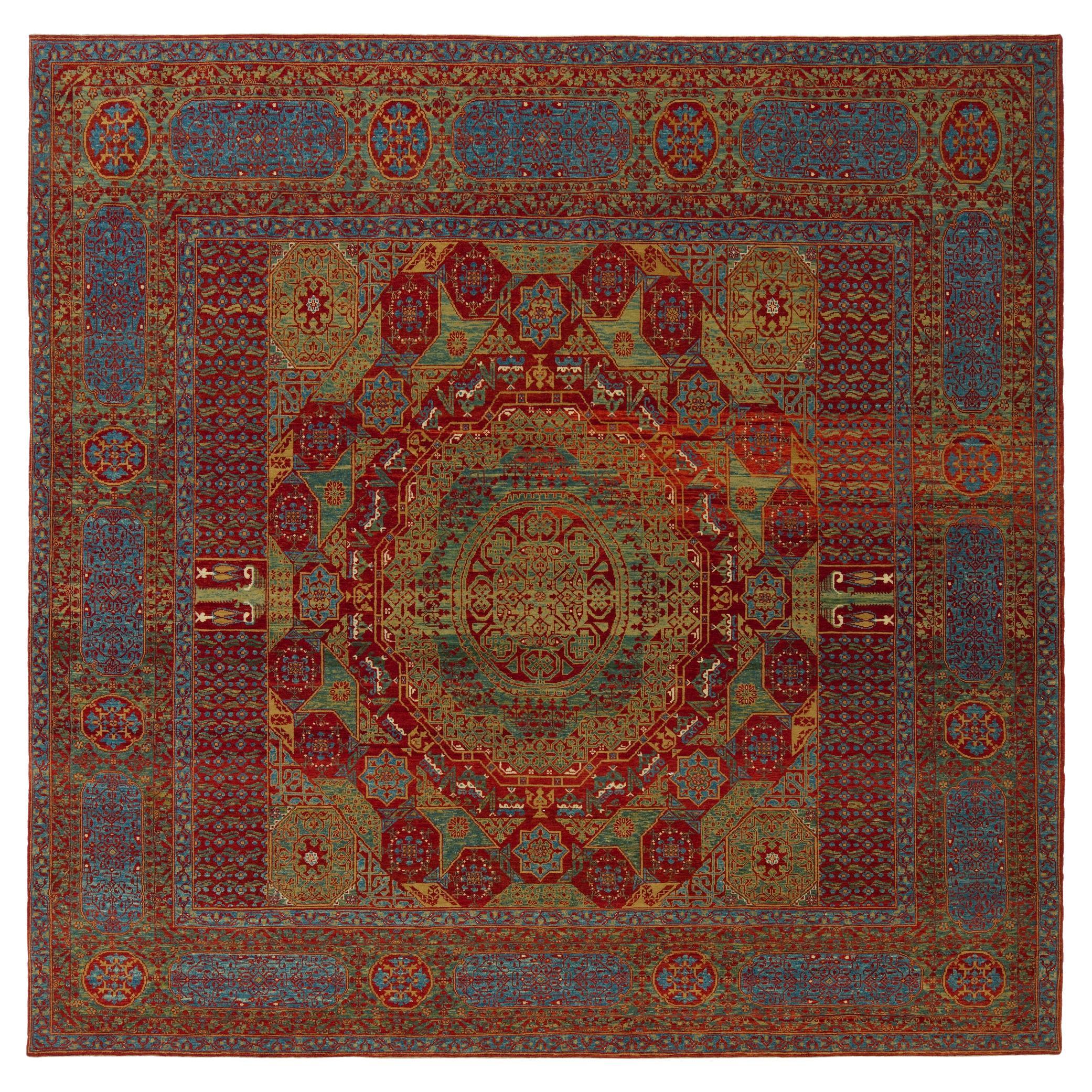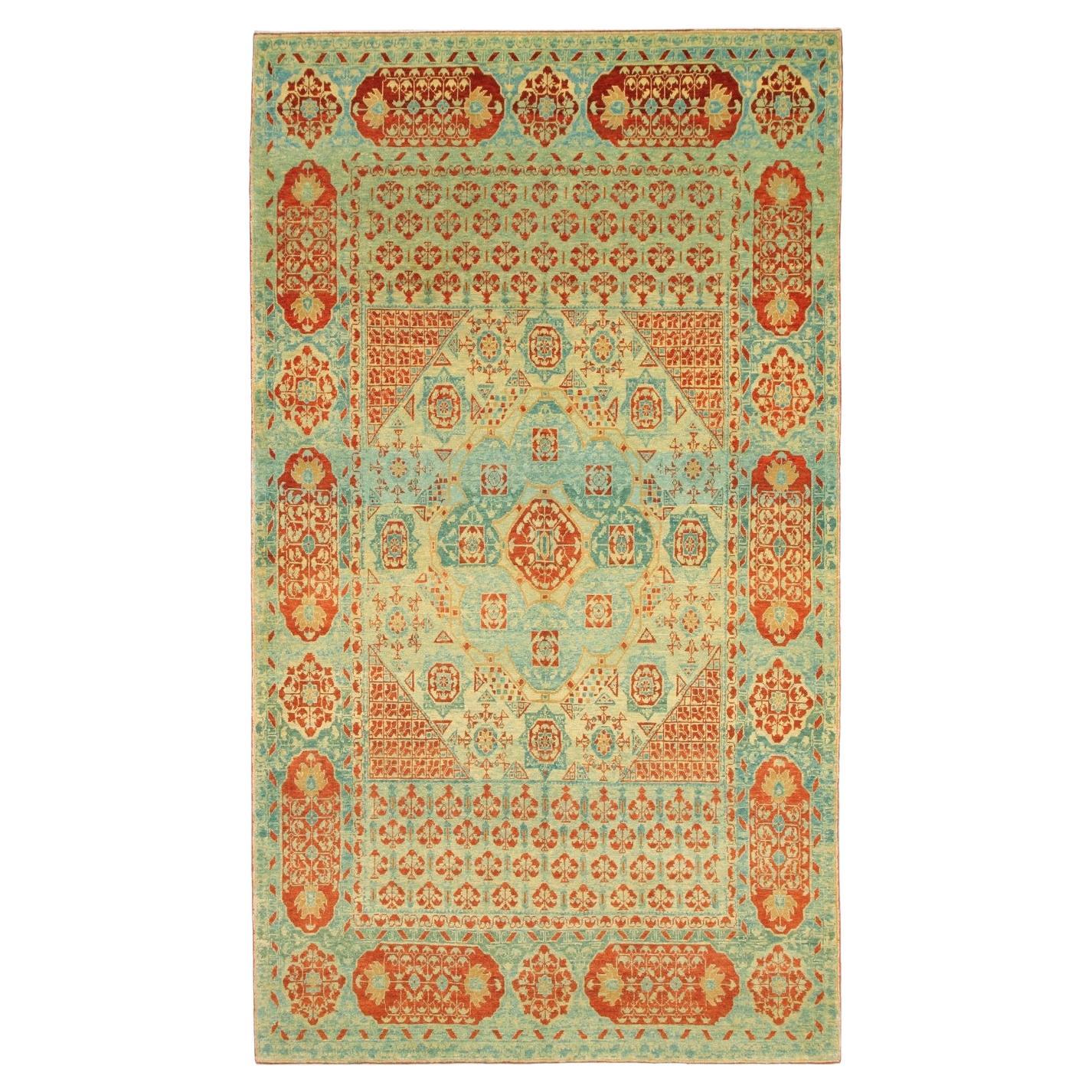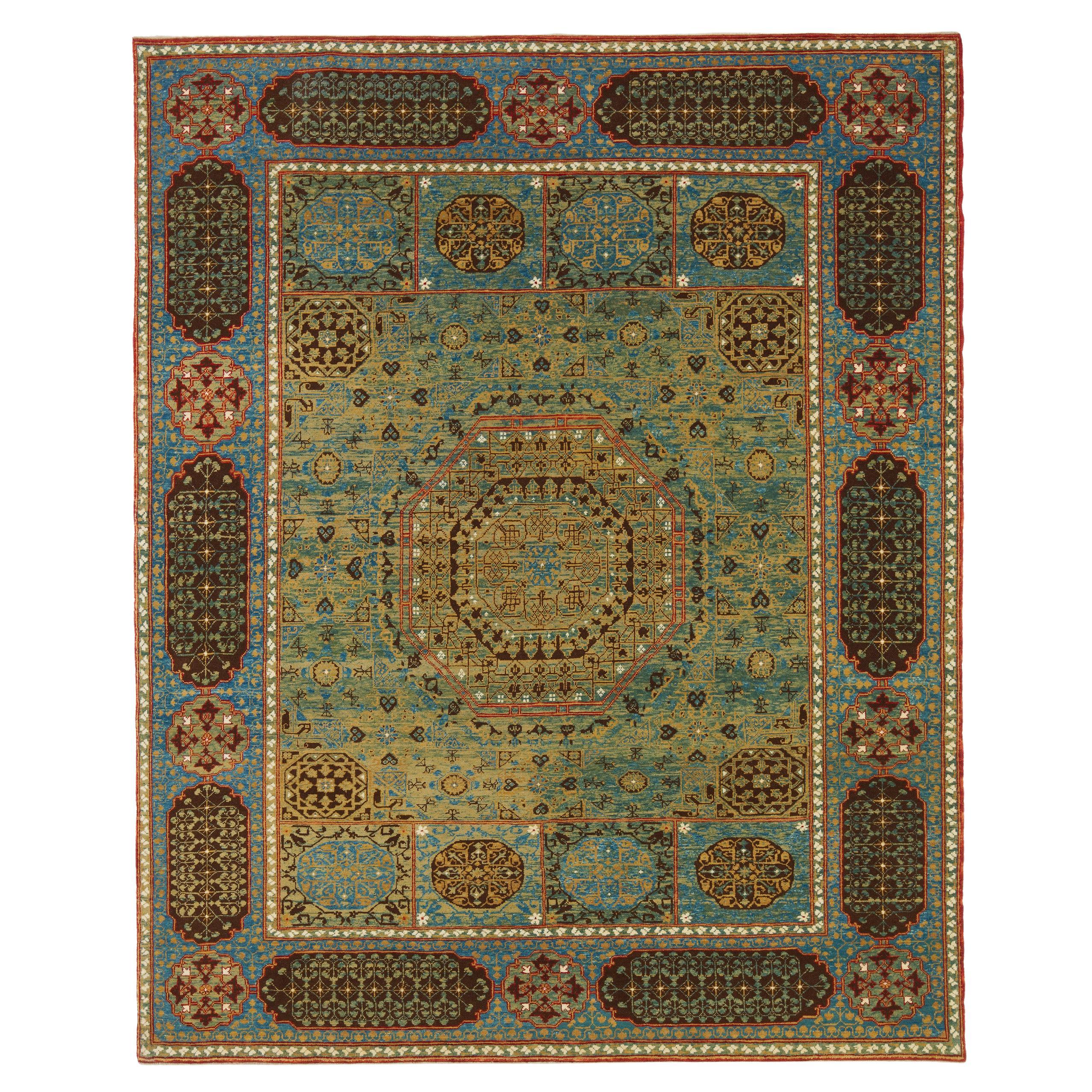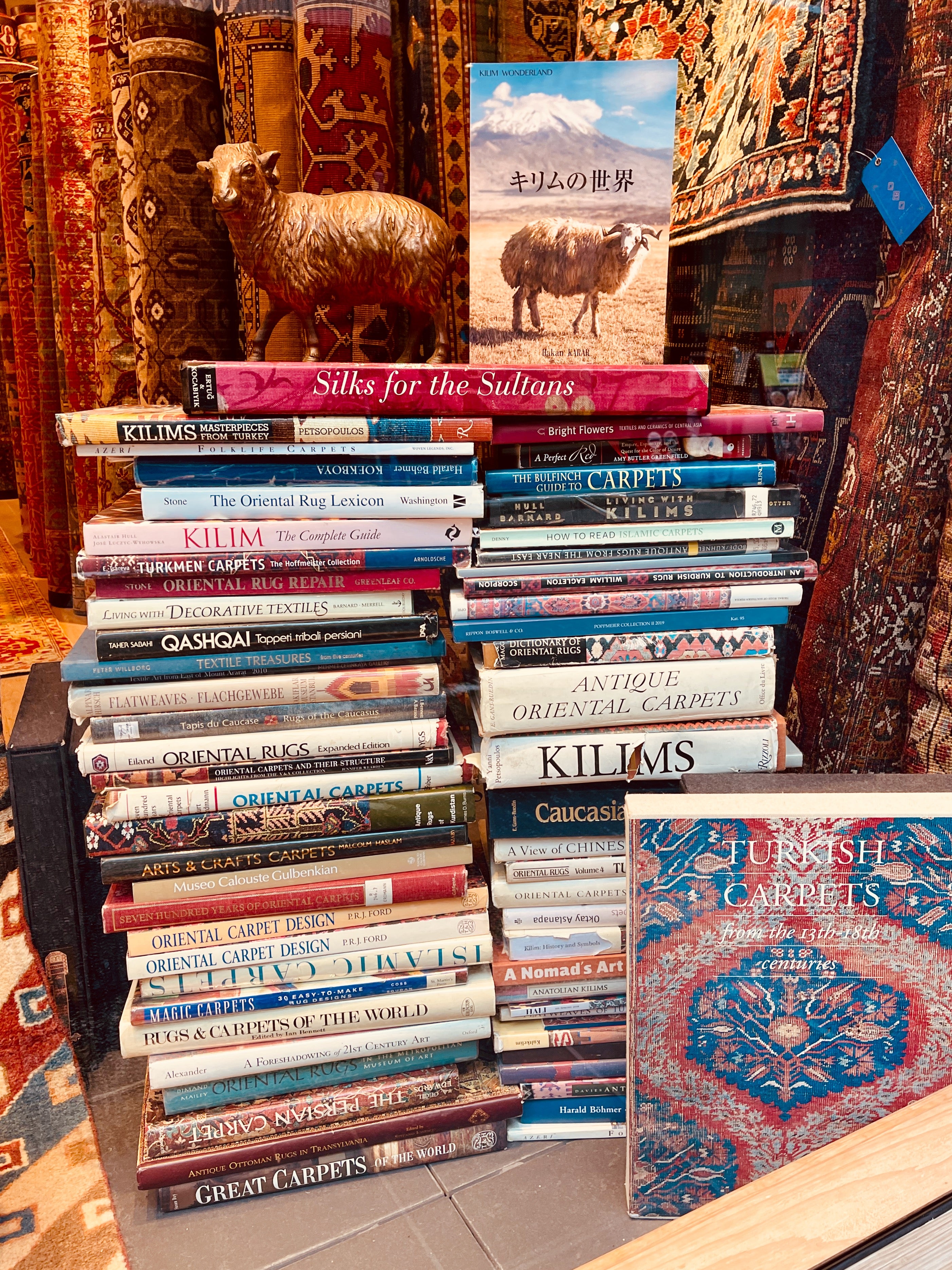Items Similar to Ararat Rugs the Simonetti Mamluk Carpet 16th Century Revival Rug, Natural Dyed
Want more images or videos?
Request additional images or videos from the seller
1 of 5
Ararat Rugs the Simonetti Mamluk Carpet 16th Century Revival Rug, Natural Dyed
About the Item
The source of carpet comes from the book How to Read – Islamic Carpets, Walter B. Denny, The Metropolitan Museum of Art, New York 2014 fig.61,62. The five-star-medallion carpet was designed in the early 16th century by Mamluk Sultane of Cairo, Egypt. It is exhibited at The Metropolitan Museum of Art, New York as The ‘Simonetti’ Carpet. The conventional practice of naming Islamic carpets either after the place they were found (“Nigde Carpet”) or after a previous owner (“Anhalt Carpet”) in this case memorializes the former Italian owner of this magnificent example of fifteenth-century Cairene weaving under the Burji Mamluk dynasty (1382–1517). The Simonetti Carpet is commonly called a “five-color Mamluk carpet” because of its color palette. The materials (most notably S-spun, or clockwise-spun, wool), dyestuffs (a limited range of colors including a purple-red made from the lac insect), and distinctive repertoire of geometric designs are all characteristic of Mamluk carpets from the period. The width, about ninety-four inches (239 cm), is typical for contemporaneous carpets woven in Cairo. A roller-bar loom was used to make the carpet: the unwoven warps were unwound from a rotating cylindrical wood roller at the top of the loom, and the finished carpet was then wound up around a similar roller at the bottom. This method allowed the same loom to be employed to weave both very long and relatively short carpets of the same width. The Simonetti displays three of the geometric medallion designs usually seen in short Mamluk carpets (two of them repeated, combined in A-B-C-B-A sequence) in one very long, impressive work of art.
Mamluk carpets originated in a physical environment that lacked the combination of abundant marginal grazing land and a temperate climate with cool winters that were common to most carpet-weaving areas in the Islamic world. While related to a broader tradition of Turkish weaving centered in Anatolia, far to the north, the designs of these carpets include atypical elements, such as stylized papyrus plants, that are deeply rooted in Egyptian tradition. Their unusual composition and layout probably represent an attempt to develop a distinctive product that could in effect establish a “Mamluk brand” in the lucrative European export market. The uncharacteristic color scheme—devoid of the undyed white pile and employing a limited range of three or five hues in much the same value—also suggests a conscious attempt to create a particular stylistic identity. Also virtually unique in the world of Islamic carpets is the S-spun wool. It has been argued that the tradition of clockwise wool spinning originated in Egypt because of the earlier Egyptian tradition of spinning flax into linen thread. Details of the plant’s botanical structure make it impossible to spin flax fiber in the more common counterclockwise direction utilized throughout the Middle East for wool and cotton.
Mamluk carpets with the color combinations seen in the Simonetti are now generally accepted as part of an earlier tradition that has many links to the weaving of Anatolia, Iran, and Syria. The “three-color” Mamluk carpets, well represented in the Metropolitan’s collection, represent a later development that continued well after the Ottoman conquest of Egypt in 1517. Many such carpets may have been produced well into the seventeenth century, and possibly even later. (Walter B. Denny in [Ekhtiar, Soucek, Canby, and Haidar 2011]). The design of the rug is interpreted by our designers with one central star, and soft colors are used for this rug.
Color summary: 4 colors in total;
Rare Grey 105 (Specially Washed)
Natural Wool Color 37 (Specially Washed)
Dark Brown 316 (No Dye – Sheep’s Own Color)
Bamboo Beige 99 (Specially Washed)
Group: Islamic Rugs Family
Area: Mamluk
Material of Pile: Natural Dyed Hand-spun Wool
Material Warp / Weft: Wool on Wool
Structure: Symmetrical knot on depressed warp inclining to the right
Knots Density: 39x39
Production Place: Southeastern Anatolia – Adiyaman Province
Stock Location: Tokyo
Size (EU): 237 X 246cm
Size (US): 7'9" X 8'0"
Area (EU): 5.8m²
Area (US): 62.8ft²
- Creator:Ararat Rugs (Manufacturer)
- Dimensions:Width: 93.31 in (237 cm)Length: 96.86 in (246 cm)
- Style:Revival (In the Style Of)
- Materials and Techniques:
- Place of Origin:
- Period:
- Date of Manufacture:2021
- Production Type:New & Custom(One of a Kind)
- Estimated Production Time:Available Now
- Condition:
- Seller Location:Tokyo, JP
- Reference Number:1stDibs: LU8206233203992
ARARAT RUGS
We know and believe that the geography we come from, our past, and our lifestyle are the most important bond between us to carry the oriental carpet art and culture to the next generations along with our core values in our ongoing growth journey.
We are aware that the way to achieve this goal and carry this priceless art and culture to the future depends on a lot of work with all our people every day while adhering to our core values.
For us, art is meaningful in the sense that it brings together various cultures around the world. It is an honor for us that oriental carpet art and culture have been instrumental in this for centuries and that we are a part of this business.
We are tirelessly keeping an eye on auction house information around the world about carpets. New York's Metropolitan, London's Victoria & Albert Museums, and other famous art museums, as well as small specialized museums that house private collections, and books about oriental carpets to collect information on outstanding carpet designs and patterns from around the world. It's our Self-improving and Self-developing culture.
As Turkish Culture of Hospitality, the Kurdish Culture of Generosity, and as Japanese Culture of Business Punctuality; are the most important values that this multicultural background has taught and bequeathed to us. It is essential and valuable for us that you feel this feeling not only by looking at our oriental carpets but from the moment you contact us.
About the Seller
5.0
Gold Seller
These expertly vetted sellers are highly rated and consistently exceed customer expectations.
Established in 1970
1stDibs seller since 2023
12 sales on 1stDibs
Typical response time: 1 hour
- ShippingRetrieving quote...Ships From: Tokyo, Japan
- Return PolicyA return for this item may be initiated within 7 days of delivery.
More From This SellerView All
- Ararat Rugs The Simonetti Mamluk Carpet 16th C. Revival Rug, Square Natural DyedBy Ararat RugsLocated in Tokyo, JPThe source of carpet comes from the book How to Read - Islamic Carpets, Walter B. Denny, The Metropolitan Museum of Art, New York 2014 fig.61,62. The five-star-medallion carpet was d...Category
21st Century and Contemporary Turkish Revival Turkish Rugs
MaterialsWool, Organic Material, Natural Fiber
- Ararat Rugs The Simonetti Mamluk Carpet 16th C. Revival Rug, Square Natural DyedBy Ararat RugsLocated in Tokyo, JPThe design source of the carpet comes from the book How to Read – Islamic Carpets, Walter B. Denny, The Metropolitan Museum of Art, New York 2014 fig.61,62. The five-star-medallion c...Category
21st Century and Contemporary Turkish Revival Turkish Rugs
MaterialsWool, Natural Fiber, Organic Material
- Ararat Rugs The Simonetti Mamluk Carpet 16th C. Revival Rug, Square Natural DyedBy Ararat RugsLocated in Tokyo, JPThe source of carpet comes from the book How to Read - Islamic Carpets, Walter B. Denny, The Metropolitan Museum of Art, New York 2014 fig.61,62. The five-star-medallion carpet was d...Category
21st Century and Contemporary Turkish Revival Turkish Rugs
MaterialsWool, Organic Material, Natural Fiber
- Ararat Rugs the Simonetti Mamluk Carpet 16th Century Revival, Natural DyedBy Ararat RugsLocated in Tokyo, JPThe source of carpet comes from the book How to Read – Islamic Carpets, Walter B. Denny, The Metropolitan Museum of Art, New York 2014 fig.61,62. The five-star-medallion carpet was d...Category
21st Century and Contemporary Turkish Revival Turkish Rugs
MaterialsWool, Natural Fiber, Organic Material
- Ararat Rugs the Simonetti Mamluk Carpet 16th Century Revival Rug, Natural DyedBy Ararat RugsLocated in Tokyo, JPThe source of carpet comes from the book how to Rread – Islamic Carpets, Walter B. Denny, The Metropolitan Museum of Art, New York 2014 fig.61,62. The five-star-medallion carpet was ...Category
21st Century and Contemporary Turkish Revival Turkish Rugs
MaterialsWool, Natural Fiber, Organic Material
- Ararat Rugs the Simonetti Mamluk Carpet 16th Century Revival Rug, Natural DyedBy Ararat RugsLocated in Tokyo, JPThe source of carpet comes from the book How to Read – Islamic Carpets, Walter B. Denny, The Metropolitan Museum of Art, New York 2014 fig.61,62. The five-star-medallion carpet was d...Category
21st Century and Contemporary Turkish Revival Turkish Rugs
MaterialsWool, Natural Fiber, Organic Material
You May Also Like
- Early 20th Century Champagne Colored Turkish Handmade Oushak CarpetLocated in New York, NYAn antique Turkish Oushak carpet handmade during the early 20th century with an overall neutral and earth tone palette primarily in champagne, old ivory, and brown.Category
Early 20th Century Turkish Rustic Turkish Rugs
MaterialsWool
- Turkish Figural 20th Century RugLocated in New York, NYMid-20th century anatolian mat with a peculiar facial motif on a lavender field. Measures: 1'7" x 2'7”.Category
Mid-20th Century Turkish Folk Art Turkish Rugs
MaterialsWool
- Lion Turkish 20th Century Wool RugLocated in New York, NYA mid-20th century authentic Turkish rug depicting a lion on a striated purple ground. Measures: 1'10" x 3'2”.Category
Mid-20th Century Turkish Folk Art Turkish Rugs
MaterialsWool
- Antique Oushak Carpet, Oriental Rug, Handmade Rug Saffron, Light Blue and CoralLocated in Port Washington, NYWest Anatolia is one of the largest weaving regions in Turkey. Since the 15th century, Turkish rugs have always been on top of the list for having fine oriental rugs. Oushak rugs su...Category
Antique Late 19th Century Turkish Oushak Turkish Rugs
MaterialsWool
- Antique Oushak Carpet, Handmade Oriental Rug, Pale Blue Green, Yellow, Coral RugLocated in Port Washington, NYWest Anatolia is one of the largest weaving regions in Turkey. Since the 15th century, Turkish rugs have always been on top of the list for having fine oriental rugs. Oushak rugs s...Category
Antique 1880s Turkish Oushak Turkish Rugs
MaterialsWool
- Antique Oushak Carpet, Oriental Rug, Handmade Rug Saffron, Light Blue and CoralLocated in Port Washington, NYTurkish carpet from Oushak with a combination of soft colors having an all-over design. Finely woven, having the most superb wool found in the mountains of Anatolia. This is a fine e...Category
Antique Late 19th Century Turkish Oushak Turkish Rugs
MaterialsWool






